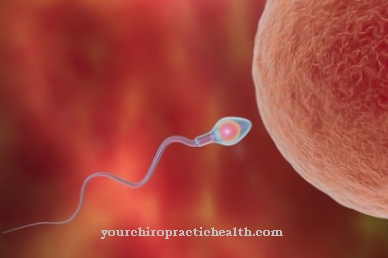Dark adaptation (also: Dark adaptation) describes the adaptation of the eye to the darkness. The sensitivity to light increases as a result of various adaptation processes. Dark adaptation can be disturbed due to a congenital or acquired disease.
What is dark adaptation?

The human eye can adapt well to different lighting conditions. It works day and night. If the lighting conditions in the surroundings deteriorate, the eye adapts to the increasing darkness. This process is called dark adaptation.
Several processes take place: the eye switches from cone to rod vision, the pupil expands, the rhodopsin concentration in the rods increases and the receptive fields of the ganglion cells expand. These adjustments increase the eye's sensitivity to light and thus enable vision in the dark (scotopic vision).
The visual acuity is reduced compared to seeing during the day. In addition, differences in brightness can be perceived in the dark, but colors can hardly be distinguished. Complete adaptation takes about 10 to 50 minutes. However, it depends on the previous lighting conditions and can also take significantly longer.
Function & task
When entering a dark room, the human eye can initially see nothing or almost nothing. After a few minutes, however, the eye has adapted to the new lighting conditions to such an extent that outlines can be recognized. It can take 50 minutes or more to achieve maximum vision in the dark.
In the meantime, various adaptation processes take place in the eye. Three of the four processes involved in dark adaptation take place in the retina of the eye. There are sensory cells in the retina that act as receptors. They register the light that falls through the pupil into the eye. They convert this stimulus into electrical signals, which they pass on to the nerve cells (ganglion cells) behind them.
Each of these ganglion cells covers a certain area of the retina whose stimuli it receives. That means: Each ganglion cell receives information from a certain group of receptors. Such an area is called a receptive field. The smaller the receptive field, the higher the visual acuity. The electrical signals received by the ganglion cells are passed on via the optic nerve to the brain, where they are processed.
There are two types of receptors in the retina that register light: cones and rods. They specialize in different tasks. The cones are responsible for seeing during the day (photopic vision), the rods for seeing in twilight and at night. The pigment rhodopsin (visual purple) is located in the rods. This changes chemically with the incidence of light and thus sets the process in motion by which the stimulus is converted into an electrical signal.
When it is bright, this conversion requires a lot of rhodopsin, which decreases its concentration. In the dark, however, the rhodopsin regenerates. It is responsible for the rods' sensitivity to light. The higher the rhodopsin concentration, the more light-sensitive the rods and therefore the eyes.
Four different processes take place during dark adaptation:
- 1. The eye switches from cone vision to rod vision. Since the rods are more sensitive to light, they can perceive weak light sources better. While colors can be differentiated and contrasts can be recognized with cone vision and visual acuity is high, only differences in brightness can be perceived with rod vision.
- 2. In the dark the pupil dilates. As a result, more light falls into the eye, which the rods can convert into signals.
- 3. The rhodopsin concentration gradually regenerates. This increases the sensitivity to light. It takes about 40 minutes to achieve the greatest possible sensitivity to light in the dark.
- 4. The receptive fields expand. As a result, the individual ganglion cell receives information from a larger area of the retina. This also results in a higher sensitivity to light, but also leads to less visual acuity.
You can find your medication here
➔ Medicines for visual disturbances and eye complaintsIllnesses & ailments
Various congenital or acquired diseases can negatively affect dark adaptation and night vision. If seeing in the dark is very limited or no longer possible, one speaks of night blindness (nyctalopia). Sometimes there is also an increased sensitivity to glare. However, daytime vision is not hindered. Usually both eyes are affected by night blindness.
Congenital night blindness can have various causes. It can be a sign of abnormal retinal changes, such as those that occur in retinopathia pigmentosa. In this disease, the sensory cells in the retina are gradually destroyed. The first thing to do is to destroy the rods, which increases night blindness. Congenital stationary night blindness, on the other hand, results from mutations in the genome that prevent the rods from functioning properly.
Congenital night blindness cannot be treated. In the case of acquired night blindness due to a vitamin A deficiency, the function of the rods is also disturbed. Vitamin A is part of rhodopsin, which is crucial for the function of the rods. A deficiency disrupts the regeneration of the pigment. It occurs when either too little vitamin A is supplied or the body cannot absorb the vitamin from food.
Night vision can also be impaired by various other diseases. This includes cataracts, which, among other things, make it difficult to see at dusk due to the clouding of the lens. As a result of diabetes mellitus, retinal damage can occur.
Since various muscles and nerves are involved in the process of dark adaptation, muscular and neurological diseases (such as muscle paralysis and optic nerve inflammation) can also impair adaptation to darkness.

















.jpg)







.jpg)


